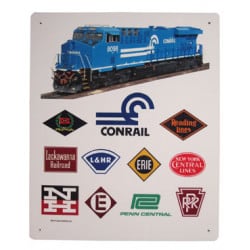Each of us is molded by others.
Shaped by teachers; later by coaches and mentors.
There is a spark that brought each of us to the stage we now share with others. It’s a passage of wisdom. Sometimes darkened by failures along the way.

In the spirit of Thanksgiving, I’d like to introduce you to a few of my railway market mentors.
My most strategic railway mentor was James McClellan. He was known to practically all of one generation of railroad executives during the period 1970 to about 2005. My experience with Jim occurred three different times – after which we often were at competing organizations.
Allow me to share just a part of Jim McClellan’s critical insight about the railway market. His thoughts are still relevant today.
These notes about his railroading ideas are found in my private correspondence and in a few pieces shared with me by others like railway journalist Fred Frailey.
Railroading 101 lessons from McClellan started in 1973-75 as we were introduced to the failing Penn Central and six other bankrupt eastern railroad companies. They could not be financially reorganized under federal laws. A mega-merger into a nationalized company had to be the solution.

The resulting CONRAIL (Consolidated Rail Company) was created in less than 600 days.
McClellan led the tactical work of a small crew of less than 20 in knitting that plan together.
He was tireless. He knew that perfection wasn’t possible – but that the right orientation and structural approach held the future course for success.
Some of us lacked confidence. His “hook” was simple – “you’re probably the best chance to write this section up since you know more about your chosen rail area. If you don’t show up, someone else will write a poorer solution. Are you with me?”
Another lesson was “ignore the happy talk.”
The federal government wasn’t going to put in enough money for a truly holistic rebuild solution. “We need to make hard choices. Those choices will make you unpopular in many places,” he warned.

Jim McClellan was in favor of keeping trains and the railcars in them running as much as possible each day. “You make money by running big trains and keeping them in motion,” Jim would say.
That wisdom was passed along two decades before Precision Scheduled Railroading (PSR) was proposed.
Regulation in the old days, he would say, sought a “fairness” in decisions rather than outright efficiency.

Then the massive failure of the northeastern system called “Penn Central” changed the entire structure and the culture of railroading and regulation.
McClellan recognized that the old ways of getting business – and finding essential new business to replace what trucks were taking – was to contract the business as much as possible.
The old ways of selling directly were disappearing.
He didn’t see many market “home run” opportunities. There would be very few victories upon which to grow the business with something like a brand-new auto plant.
Yet there was some growth out there. It came from the unexpected Powder River coal fields.
McClellan warned us, however, that the Appalachian coal might suffer a different fate.

He saw the advantages of the double-stack intermodal operation. Yet he also supported some testing of smaller size/smaller density bi-modal truck-like service with the Roadrailer technology (truck bodies that had special rail bogie units and no railroad car).
He focused on using the trucking organization to run this bi-modal shorter lane truck operation. He wanted to build a different type of selling approach then the railroad had.
Sadly, it wasn’t successful in the long run.
The lesson learned is that mentors sometimes don’t get it all right. We all make mistakes or lose control over our experiments. He warned us that it’s part of being in an organizational structure that resembles the hierarchy of a Civil War Army unit.

Lessons for short-haul intermodal rail were also disappointing.
Jim occasionally opined that “as appealing as the short-haul competitive situation might be to many of us, I do not think that the stars are aligned for that outcome.” Why? “Too many work rules, public policy and management attitude barriers,” he would sigh.
“Class 1 railroads can survive without coal, but I cannot find an example of a railroad that prospered on short- haul merchandise traffic.” Jim acknowledged that short lines were occasionally a noted exception.
He believed in mergers, at least in our private conversations. Yet he realized that the ultimate combination of perhaps two to three “transcontinental systems” might be handicapped by the return of regulatory heavy hands.
While the economics of mergers did not automatically create a better financial outcome, McClellan nevertheless had seen first-hand that when executed well there were significant productivity improvements and market service improvements.
In the end, McClellan also taught his mentored executives that freight railroads thrive on traffic density. But he warned that service metrics are the draw to keep and grow customers.
Before Jim McClellan left us, he mentioned the Canadian National Railway as a success story. But he noted, “CN has a credible model, but it also has a near 2,500-mile length of haul market.” His point was that distance and density matter.

Other mentors that left their mark
C. Gary Collins was a light density line and western railway operating teacher. He did not have the flair of McClellan… just steady ahead eyes with an awareness of where strengths and weaknesses lie in each railroad. One of his insights was the excess of locomotive power sitting in remote yards woefully underused.
Gardner Rogers was another mentor – and a civil engineer. He taught his young railroad charges the tricks of balancing capital assets against the need to have a realistic financial return on investment. His career spanned both the Western Pacific (now part of Union Pacific) and Northwestern Australia’s iron ore railway construction project. His was of gentle and bright eye demeanor. He captured attention with his smile. Then gently engaged your brain.
Jim Hagen taught federal railroad planners’ patience. He taught his teams at CSX and Conrail how to measure markets, price for commercial success, and even how to exit markets where you have little chance of success against trucks or barges. He and McClellan both partnered and competed over their careers.
There was Dick Hasselman, Conrail’s senior vice president of all operations, who taught by asking simple questions of those who approached him. At first so simple that he often disarmed the youngsters’ ideas. He was probing us to find evidence for our ideas.
Then there was David LeVan. He saw the inevitability of a coming merger. As a CPA, he understood that cutting costs as your way towards prosperity had its limits. His financial and blended accounting vision saw the need to grow Conrail’s size. He taught financial strategic thinking.

Takeaway
Mentors taught my generation that rail markets are constantly evolving. And threatened. Change is continuous.
This week is the time for you, my railroad market audience, to reflect. To give thanks in part to those who are today helping your career.
Look around when your get back to work next week.
Find them. Keep them close.
Listen. Take notes.
In your own way, say thank you.
Your time to mentor, my friends, is coming.







